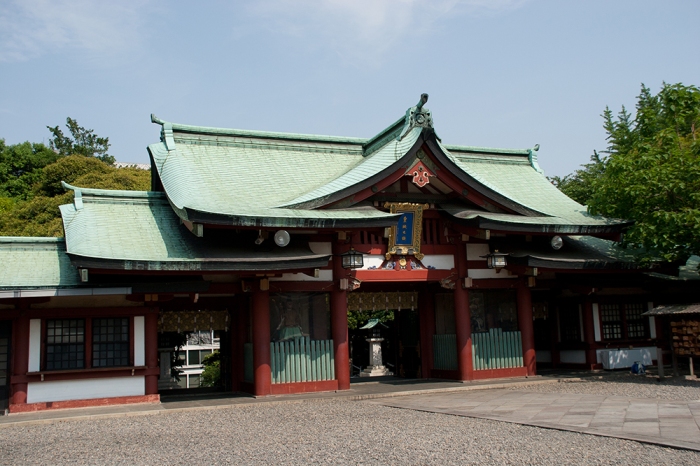For a shrine which was once so important, Hie Jinja is remarkably… unremarkable. It receives few foreign visitors, and seems relatively new. The first clue to its magnitude is the vast quantity of names and nicknames it has; it’s not uncommon for a shrine so big as Sensōji to have a couple of alternative names, but Hie Jinja? Hie Jinja has more than seven names.
This colourful little shrine tucked away in Nagatachō was once the protector of Edo Castle, and until the dissolution of State Shinto in 1946 it was among the Kanpei-taisha, the first rank of government-supported shrines. Alas the shrine has been relocated a few times in its existence, then destroyed altogether by bombing in World War II. What stands today is a 1958 reconstruction, but it does nonetheless hold several important national treasures.
The traditional entrance to Hie Jinja is lined with a hundred vermilion torii, but a new, broad entrance touches down on Sotobori-dōri, complete with a single concrete torii and two pairs of escalators. Despite officially being in Nagatachō, this entrance is only a short walk from Akasaka.
The shrine’s main deity is Ōyamakui-no-kami, the kami of Hie Mountain in Shiga Prefecture. There are several monkey statues here, as monkeys are Ōyamakui-no-kami’s messengers, much as foxes are Inari’s.
Monkeys are also seen to be good with children, and have taken on the role of protector of children, families, and matrimony.
Hie Jinja is also the host of one of Edo’s three great festivals, the Sannō Matsuri in June. During the Edo Period the festival would be attended by the Shōgun himself, and nowadays the route of the matsuri’s mikoshi finishes at the Imperial Palace. For the rest of the year the shrine is a surprisingly peaceful getaway from the bustle and noise at street level.
It’s also a fantastic place to visit during cherry blossom or autumn colour, the shrine being surrounded by a variety of trees including cherry. And on New Year’s, hundreds of different ema are available – so many that they are displayed on a board so that you can pick before you approach the counter and order them by number.
Visiting Hie Jinja:
Take the Marunouchi or Chiyoda Lines to Kokkaigijidomae Station. Hie Shrine is a 5-10 minute walk. Alternatively take the Chiyoda Line to Akasaka Station, from which the shrine is again a 5-10 minute walk.
Admission: Free.





